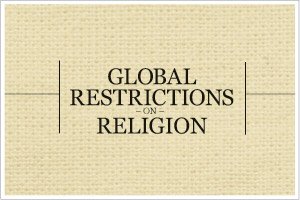Global Restrictions on Religion – December 2009

For more than half a century, the United Nations and numerous international organizations have affirmed the principle of religious freedom. For just as many decades, journalists and human rights groups have reported on persecution of minority faiths, outbreaks of sectarian violence and other pressures on religious individuals and communities in many countries. But until now, there has been no quantitative study that reviews an extensive number of sources to measure how governments and private actors infringe on religious beliefs and practices around the world.
Global Restrictions on Religion, a study released 17 December 2009 by the Pew Research Center’s Forum on Religion & Public Life, finds that 64 nations – about one-third of the countries in the world – have high or very high restrictions on religion. But because some of the most restrictive countries are very populous, nearly 70 percent of the world’s 6.8 billion people live in countries with high restrictions on religion, the brunt of which often falls on religious minorities.
Some restrictions result from government actions, policies and laws. Others result from hostile acts by private individuals, organizations and social groups. The highest overall levels of restrictions are found in countries such as Saudi Arabia, Pakistan and Iran, where both the government and society at large impose numerous limits on religious beliefs and practices. But government policies and social hostilities do not always move in tandem. Vietnam and China, for instance, have high government restrictions on religion but are in the moderate or low range when it comes to social hostilities. Nigeria and Bangladesh follow the opposite pattern: high in social hostilities but moderate in terms of government actions.